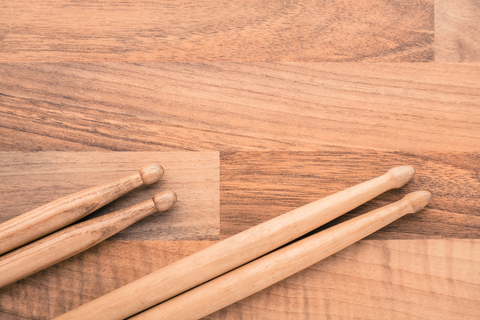Searching for a drumstick.

Drumsticks! Are they really that different? You bet they are, and for good reason too! Drummers have their favorite drumsticks for a variety of reasons. Some play in orchestras, bands and ensembles of various sizes and genres of music, which may call for the use of the many of the varied types of drumsticks that are on the market.
There are different materials, both natural and synthetic, that are manufactured to achieve the results desired by musicians who are producing today’s music in a variety of musical situations.
As far as myself goes, my choice of drumsticks are the Buddy Rich signature series drumsticks. To be more precise, the Buddy Rich (SBR), is an “A modified 5A with a larger tip, neck and shoulder, made from hickory with an L= 16 5/16th” Dia=.590” wood tip drumstick. What does that mean? Type of drumsticks, Buddy Rich Signature Series, hence the SBR. Size: Modified 5A (Size 5 orchestra), larger tip, which in this case, the stick has a shorter neck and thicker shoulder. The length being 16 and 5/16th inches long, it is one of the longest in terms of length, since most drumsticks are between 15” and 17” in length.
The most common types of wood that drumsticks are made from are Hickory, Maple and Oak. Hickory is the most common type of wood used to make drumsticks. Here is a better description of each of the drumstick wood types:
- Hickory – Hickory is the most common type of wood used to make drumsticks. Drumsticks made from hickory can sustain a very significant amount of damage before breaking. They chip away instead of splitting or breaking in two. When drumming, the shock from hitting the drum will stay in the wood instead of being transferred to the drummer’s hands, wrists or arms.
- Maple – Maple is a very lightweight wood and maple drumsticks are usually thicker to offset the wood’s weight. Because the wood is so light, maple drumsticks are useful when playing musical applications that require a significant amount of speed and precision.
- Oak – Oak is the heaviest wood of the three and because of that, oak drumsticks are usually thinner in diameter so that they do not feel clunky or heavy in a drummer’s hands. Oak’s weight also makes drumsticks more durable. They are able to sustain more damage than hickory before breaking. But unlike hickory, oak drumsticks are likely to split in two, instead of just chipping away, when they are exposed to excessive force or impact.
There are five main parts of a drumstick which are very important when choosing to make a purchase; all drummers should know the parts and what they mean. They are the Bead or Tip, the Neck, the Shoulder, the Shaft and the End or Butt. All of these parts are very important to know because they are what makes playing just a little bit easier and less stressful for the player. Each of these five parts play a very important role in the life of the drumstick.
There are three basic ways to identify what type of drumstick and their uses are. For example, sticks that are labeled 5A means size 5 orchestra, 3S is size 3 street, 5B is size 5 band. Size 5B is heaver that 5A and 3S is usually thicker than both the 5A and 5B. The S size drumsticks are marching band sticks. Also, you might see something like 5BN which means size 5 band nylon tip.
Here are some of the most popular brands of drumsticks on the market today: Vic Firth, Pro-Mark, Regal Tip, Vater, Zildjian, Agner, Tama Drums, Silver Fox, Stagg, Innovative Percussion, and Cooperman. Over a period of time, most drummers go through many types of drumsticks before settling down to maybe one or two brands they may use over a period of a lifetime.
In closing, this is just a basic overview of the many options the drummer has when choosing drumsticks. And I haven’t even written about brushes yet!

You must be logged in to post a comment Login